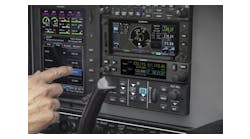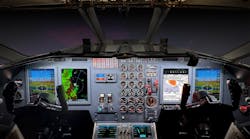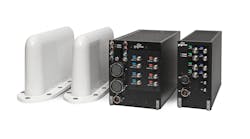Yes, the title is intended to be a pun and it does highlight a genuine issue in supporting aircraft of today.
A radome is a covering whose primary purpose is to protect an antenna often associated with ultra high frequency devices operating in the GHz range such as weather radar and satellite telephone systems. It is a part of the airframe and must possess certain physical as well as electrical properties. It should be strong enough to withstand the effects of elements encountered in flight and yet be contoured to minimize drag.
These properties vary with the shape, design speed, and size of the aircraft on which it is to be installed. Electrically, it should permit the passage of transmitted signals and any returns with minimum distortion and absorption. A certain electrical thickness has to be achieved which is related to operating frequency, and the type of material and construction used. The electrical thickness is specified for a certain range of operating frequencies. Radar efficiency depends upon a clear, nondistorted, reflection free antenna view through the radome.
Consequently, precision in construction will provide optimum performance.
Types of radomes
There are two general types of radomes. The “thin wall” and “sandwich” types.
Thin wall devices are considered to be thin relative to the wavelength of the radar. They are useful when the frequency is low enough to permit a skin thickness which will satisfy the structural requirements. Sandwich types consist of two or more plastic skins separated by a dielectric core. The core may consist of honeycomb plastic sections, hollow flutes, or foam plastic.
The dielectric and separation of the skins will depend upon the wavelength of the radar frequencies.
Static electricity
Unfortunately, it is necessary to manufacture certain antenna fairings from di-electric materials making them a prime source of static generation.
As the speed of the aircraft increases, so does the friction of the air passing over the surface which increases the charge. Aircraft cruising at low speeds are less likely to be affected. Shape is another factor, therefore small pointed radomes tend to build charges faster than large blunt ones.
In low humidity conditions the static electricity on a radome surface can build up resulting in spark discharging causing radio interference over a wide band of frequencies. Surface damage often appears as chipping of the paint and small pits or pinholes burned in the surface. These punctures rapidly increase in size as carbon deposits resulting from the charring encourage further strikes. If unchecked, additional damage will occur from water penetrating the surface into the core.
Lightning diverter strips extending from the frontal area of the radome to the airframe should be part of every radome installation on high-speed aircraft. These diverter strips continuously collect static buildup from the surface of the radome and conduct it to the airframe without severe sparking or arcing.
Paint and coatings
The primary function of paint on the aircraft radome is to protect from the harsh environments associated with temperature extremes, high-speed impact with abrasive particles, sunlight, and high voltage surface charges. If the coating gets damaged the protection is defeated.
Most aircraft primers and topcoats are suitable for use and include: polyester, polyurethane, alkyd-enamel acrylic, and epoxy.
Any paint finish that has a pearlescent or “metal flake” appearance should be avoided, since many of these paints contain very small slivers of aluminum or bronze metal called leafing pigments which can have a significant effect on the radar signal.
Anti-static coatings contain graphite or carbon particles to make them semi-conductive so that static charges do not build up on the radome. These coatings should be used with discretion since a heavy application can result in attenuation of the radar signal. Also ensure that the type being considered is suitable for radome use since some anti-static coatings are more conductive than others.
A good anti-static/anti-erosion coating should be applied to the frontal area of the radome. The rest of the surface should be painted with a product having a composition that promotes static bleed-off.
Special purpose protective neoprene (MIL-C-7439) and polyurethane (MIL-C-83231) finishes are recommended for situations where rain erosion is severe. The U.S. MIL-R-7705 specification requires rain erosion protection on aircraft that operate at speeds of 250 knots or above and is applied to the leading portion of the radome. Coatings are available in two classes: Type I rain erosion resistant and Type II rain erosion resistant with anti-static properties.
A radome with an excessive amount of filler and/or multiple coats of paint will experience loss of efficiency. Too thick of a coating can reduce the transmissivity of a 90 percent radome down to 50 to 60 percent. When refinishing is required, it is essential to remove all old paint and evaluate previous repairs.
Some types of lightning diverters can not be painted. Segmented and oxide coated diverters are examples of these and should be masked prior to paint.
Moisture ingress
It is critical to ensure that the substrate is protected from moisture ingress. Chips in the topcoat should be “touched up” as soon as noticed.
As composite surfaces are susceptible to contamination, cleanliness during the refinishing process is required otherwise cratering “fish eyes” or flaking of paint will occur.
Modern catalyzed epoxy and polyurethane finishes have ingredients that are both age and moisture sensitive. Do not use materials that are outdated or improperly sealed. Radome paint defects can also be caused by temperature, viscosity, application rate, spray gun pressure, and dust contamination.
Very thin fabric reinforced neoprene caps are suitable for rain erosion protection on high-speed aircraft and are generally black and formed polyurethane film erosion caps with a moisture-resistant adhesive backing are also acceptable. These “boots” are clear and allow the colors including stripes to show.
The use of plastic erosion caps can cause moisture to be trapped between the nose cap and the radome. This can set up a strong radar reflection and may result in false radar targets and ground clutter in addition to loss of radar range plus a plastic cap may not possess good electrical properties.
Maintenance program
The radome should be included as a part of the regular maintenance program. Its surface should be checked for pits, cracks, chipped paint, or other damage. Small pits can be cleaned well and sealed with a good dielectric coating.
Lightning diverter strips should be inspected to determine that they make good electrical contact and are not abraded or broken.
If an aircraft is experiencing static problems, it does not always mean the radome is faulty. The source may be with other components. All external nonmetallic parts should be suspected along with hinged assemblies, shock-mounted boxes, and instrument panels to see that they have a good electrical ground to the airframe.
Electrical interference can also result from improper shielding of the aircraft’s electrical system, interaction between radio antennas, engine ignition systems, and power sources. When troubleshooting, a unit-by-unit check should be made to eliminate all possibilities.
Radome lightning diverter strips should be checked to ensure they are properly grounded to the aircraft. If routine troubleshooting does not eliminate the problem, measure the electrical conductivity between the strip and airframe. If this is poor, remove the radome and inspect the hidden connections for breaks, weak spots, or corrosion. Worn diverter strips should be replaced and corroded terminals cleaned before reassembly.
Yes, radome finish will lend itself to the overall aesthetics of the aircraft and keep in mind “the pointy end finish first” will result in longevity and trouble-free performance.
Jim Sparks has been in aviation for 30 years and is a licensed A&P. Currently he is the manager of aviation maintenance for a private company with a fleet including light single engine aircraft, helicopters, and several types of business jets. Email: [email protected].


